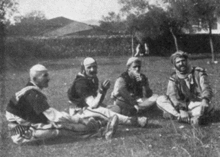Shala (tribe)

Shala (Serbian: Шаљани, Šaljani) is a tribe and region of northern Albania in the valley of Shala river.[1] Results of historical and archaeological research confirm the claim of oral histories that ancestors of Shala came to the valley several centuries ago.[2] Shala are considered as related to Kuči tribe because their ancestors came to Albania from the region of Kuči (modern day Montenegro).[3] In fact the origin of the name is derived from another Albanian language word (Albanian: shalës, shalësinë), meaning infertile land. The religion of the tribe was Catholic while the tribe had around 3,000 members at the end of 19th century.[4]
According to a legend they share a common ancestor with Shoshi and Mirdita (from three brothers, one who had saddle (Albanian: shalë), second had sieve (Albanian: shoshë) and third who had nothing wished to his brothers to have a good-day (Albanian: mirëdita)).[5] The religion of the tribe was Catholic while the tribe had around 3,000 members at the end of 19th century.[4]
Members of Shala tribe were very skillful in irrigation.[6] Branislav Nušić recorded that Shala was the poorest tribe of Albania with only small exception of around 400 families who lived in village Istinić, near Deçan.[7] Shala tribe was in conflict with Gashi tribe until they made peace in August 1879, based on sultan's order.[8]
In 1910 Shala tribe joined the Albanian revolt of 1910 and with some other tribes fought against Ottoman forces attempting to reach Shkodër.[9] In 1913 Shala tribe joined Montenegrin forces during the Siege of Scutari. When Montenegrin forces began to disarm them after the city was captured, Shala tribe rebelled.[10]
In 1926 Shala and Shoshi tribe again rebelled but this rebellion was suppressed by the gendarmes led by Muharrem Bajraktari and fighters from Dibra and Mat.[11] After World War II, the communists forced nationalist forces of Albania to retreat to Shala which they controlled throughout 1945 and 1946.[12]
See also
- Shalë municipality covered by the tribe
- Shala (surname)
- List of tribes of Albania
References
- ↑ Elsie, Robert (2010) [2004], Historical Dictionary Of Albania (2 ed.), Maryland: Rowman & Littlefield Publishing Group, p. 411, ISBN 9781282521926, OCLC 816372706,
SHALA. Northern Albanian tribe and traditional tribal region. The Shala region is situated in the Dukagjini area north of the Drin River in the District of Shkodra, basically the valley of the Shala River south of Theth.
- ↑ Helaine Silverman (1 January 2011). Contested Cultural Heritage: Religion, Nationalism, Erasure, and Exclusion in a Global World. Springer. p. 120. ISBN 978-1-4419-7305-4. Retrieved 1 June 2013.
Oral histories indicate that they arrived in the valley several centuries ago....... our historical and archeological data confirm these oral histories
- ↑ Prilozi za književnost, jezik, istoriju i folklor. Drzhavna štamparija Kralevine srba, khrbata i slovent͡sa. 1992. p. 156. Retrieved 4 June 2013.
За „близику " се са Кучима држе и арбанашка племена Шаљани и Берише јер су и њихови преци некада досељени из Куча .
- ↑ 4.0 4.1 Elsie, Robert (2010) [2004], Historical Dictionary Of Albania (2 ed.), Maryland: Rowman & Littlefield Publishing Group, p. 411, ISBN 9781282521926, OCLC 816372706,
The Shala tribe, primarily Catholic, had a population of over 3,000 in the late 19th century.
- ↑ Miranda Vickers (1999). The Albanians: A Modern History. I.B.Tauris. pp. 103–. ISBN 978-1-86064-541-9. Retrieved 6 June 2013.
- ↑ Glasnik Etnografskog muzeja u Beogradu. Muzej. 1937. p. 167. Retrieved 4 June 2013.
Шаљани су били врло вешти за извођење воде
- ↑ Branislav Đ Nušić (1966). Sabrana dela. NIP "Jež,". p. 242. Retrieved 4 June 2013.
Шаљани су најсиротније племе у целој Арбанији, од којих у богатству једва чине неки мали изузетак четири стотине кућа Шаљана који насеља- вају село Истиниће код Дечана.
- ↑ Đorđe Mikić (1988). Društvene i ekonomske prilike kosovskih srba u XIX i početkom XX veka. Srpska akademija nauka i umetnosti. p. 40. Retrieved 4 June 2013.
- ↑ Miodrag Marović (1 January 1995). Balkanski Džoker: Albanija i Albanci : istorijska hronika nastajanja i razvoja albanskog pitanja. Kulturni centar. p. 181. Retrieved 26 July 2013.
Sačekala su je planinska plemena Malisori, Gaši, Krasnići i Šalje
- ↑ Armand Leon Baron von Ardenne; Hans Ferdinand Helmolt. Das Buch vom grossen Krieg. Union Deutsche Verlagsgesellschaft. p. 238. Retrieved 3 June 2013.
Приликом зау- зимања Скадра Црногорцима се придружило албан- ско племе Шаља, које су, међутим, они касније по- чели разоружавати. То је Шаљане увредило и изазвало на побуне и акције против црногорских је- диница и посада
- ↑ Jason Tomes (26 September 2003). King Zog: self made monarch of Albania. Sutton. p. 95. ISBN 978-0-7509-3077-2.
- ↑ Glasnik Srpskog istorijsko-kulturnog društva "Njegoš". (in Serbian). Njegoš. 1996. p. 12. Retrieved 25 July 2013.
Предјаким комунистичкимснагама, албански националисти морали су да се повуку у племе Шаља. То племе остало је у њиховим рукама читаве 1945. и 1946. године.